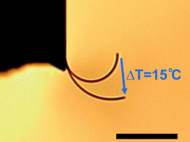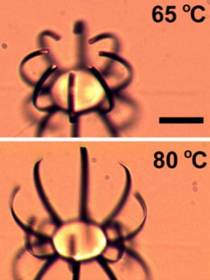Vanadium dioxide microactuator could be used in micro robotics
 A group of researchers from the Lawrence Berkeley National Laboratory (Berkeley Lab) and the University of California, Berkeley, have developed a new microscale actuator which could find its application in novel microfluidics, drug delivery, and artificial muscles. The actuators are smaller than the width of a human hair and are based on an oxide material that expands and contracts dramatically in response to minute temperature variations.
A group of researchers from the Lawrence Berkeley National Laboratory (Berkeley Lab) and the University of California, Berkeley, have developed a new microscale actuator which could find its application in novel microfluidics, drug delivery, and artificial muscles. The actuators are smaller than the width of a human hair and are based on an oxide material that expands and contracts dramatically in response to minute temperature variations.
“We believe our microactuator is more efficient and powerful than any current microscale actuation technology, including human muscle cells”, said Junqiao Wu, Berkeley Lab and UC Berkeley scientist. “What’s more, it uses this very interesting material—vanadium dioxide—and tells us more about the fundamental materials science of phase transitions.”
Wu and his colleagues arrived at the microactuator idea by accident, while studying vanadium dioxide – a textbook example of a strongly correlated material which has been an object of scientific research for decades. Once vanadium dioxide gets heated past 67°C (152.6°F), it transforms from an insulator to a metal. This isn’t the only change which occurs during this process, since it also goes through a structural phase transition that shrinks the material in one dimension while expanding in the other two.
In his previous research, Wu shed light on whether one of these phase transitions drives the other or if they are separate phenomena that coincidentally occur at the same temperature. He and his colleagues isolated the two phase transitions in single-crystal nanowires of vanadium dioxide and demonstrated that they are separable and can be driven independently.
During the tests, the nanowires shrunk and broke away from their electrode contacts during the structural phase transition. To take advantage of this phenomenon, the researchers fabricated a free-standing strip of vanadium dioxide with a chromium metal layer on top. When the strip is heated via a small electrical current or a flash of laser light, the vanadium dioxide contracts and the whole strip bends like a finger.
“The displacement of our microactuator is huge – tens of microns for an actuator length on the same order of magnitude—much bigger than you can get with a piezoelectric device—and simultaneously with very large force. I am very optimistic that this technology will become competitive to piezoelectric technology, and may even replace it”, said Wu.
According to researchers, these microactuators could be used as tiny pumps for drug delivery or as mechanical muscles in micro-scale robots. Wu and his colleagues are already partnering with the Berkeley Sensing and Actuation Center to integrate their actuators into devices for applications such as radiation-detection robots for hazardous environments. Berkeley Lab researches also plan to increase the usability of these microactuators by creating a torsion actuator, which is a much more challenging prospect.
For more information about the previous research related to vanadium dioxide, read the article published in the journal Physical Review Letters: “Decoupling of Structural and Electronic Phase Transitions in VO2”.
For more information about the microactuators, read the article published in the journal Nano Letters: “Giant-Amplitude, High-Work Density Microactuators with Phase Transition Activated Nanolayer Bimorphs”.










Leave your response!